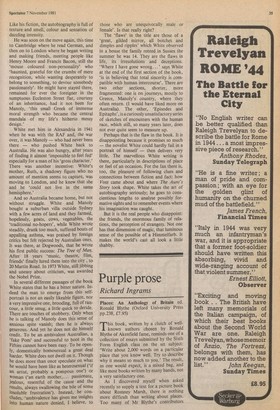Purple prose
Richard In grams Places: An Anthology of Britain ed. Ronald Blythe (Oxford University Press pp.238, £7.95) rT1 his book, written by a clutch of well ]. known authors chosen by Ronald Blythe of Akenfield fame, reminds one of a collection of essays submitted by the Sixth Form English class on the set subject: 'Write about 2,000 words on a particular place that you know well. Try to describe why it means so much to you.' The result, as one would expect, is a mixed bag, and like most books written by many hands, not a very satisfactory one. As I discovered myself when asked recently to supply a text for a picture book about Romney Marsh, there is nothing more difficult than writing about places. Too many of Mr Blythe's contributors become nostalgic — somewhere revisited, a favourite place remembered from childhood . . . It would have been better perhaps if the book had been more urban. It is comparatively easy to write about a town. One can describe the buildings, the shops, the people. But the countryside!
Confronted by nature in the raw, most writers run mildy amok and say things they would never dream of saying in other circumstances. `Patches of sheep whiten the hilly sward' (William Trevor). `Gravel crunches under my feet with a noise of exploding rockets' (James Lees Milne). `Over the mountains hung a blue grey rain curtain against which soared white gulls' (Russell Hoban). `Gulls rise up behind the plough like scurries of torn paper' (Dirk Bogarde). Why do people feel they have to write like this when they get outside?
It is particularly unnecessary when there are so many models, like Dorothy Wordsworth, who have shown that the best effects are gained by being very specific and plain. The late Barbara Pym came closest to what is required with her diary notes from Wychwood in Oxfordshire: `December. Hyacinths coming out in the house. Gathering and sawing wood for the fire is good exercise. A grey white sky and a bleak landscape.' But the best contribution is not really about a place but about people; a long and detailed description by Prof. Richard Cobb of the life lived by his grandparents in Colchester with their unmarried son Primus and their niece Daisy. This is so vividly recalled that one hopes the Professor will soon write a full length autobiography. By contrast, the article following it, by Piers Paul Read about his father's house in Yorkshire, is as dull as ditchwater and as cold.
The book is illustrated with some drawings by John Piper and a number of photographs by different hands. For reasons that I cannot understand, the pictures, often individually striking, do not relate to the text. Thus, Sir John Betjeman's essay on Padstow is accompanied by a photograph of Falmouth.



























































 Previous page
Previous page